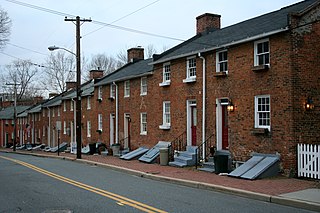
Oella is a mill town on the Patapsco River in western Baltimore County, Maryland, United States, located between Catonsville and Ellicott City. It is a 19th-century village of millworkers' homes.

The Patterson Viaduct was built by the Baltimore and Ohio Railroad (B&O) as part of its Old Main Line during May to December 1829. The viaduct spanned the Patapsco River at Ilchester, Maryland. It was heavily damaged by a flood in 1866 and subsequently replaced with other structures.

The Ellicott City Station in Ellicott City, Maryland, is the oldest remaining passenger train station in the United States, and one of the oldest in the world. It was built in 1830 as the terminus of the Baltimore and Ohio Railroad line from Baltimore to the town then called Ellicott's Mills, and a facility to service steam locomotives at the end of the 13-mile (21 km) run. The station, a National Historic Landmark, is now used as a museum.

The George Washington House, or Indian Queen Tavern, is located at Baltimore Ave., at Upshur St., in Bladensburg, Prince George's County, Maryland. It was constructed in the 1760s. The 2 1⁄2-story structure is constructed of brick Flemish bond on ends. The plan is rectangular, with a gabled roof, exterior end chimneys, gabled shingled dormers. There are first and second-story center entrances, each with a transom. There is a full-width one-story porch with balustraded deck and side entrances. The structure includes a later two-story rear addition. The structure is Georgian.

Beall's Pleasure is a historic home located in Landover, Prince George's County, Maryland, United States. The original owner of the land was Colonel Ninian Beall. He helped establish the first Presbyterian Church in Prince George's County. It was built in 1795 as the summer home of Benjamin Stoddert who later became the first Secretary of the Navy.

Larkin's Hundred, also known as The Castle, is a historic home at Harwood, Anne Arundel County, Maryland, United States. It is a two-story brick house. Although tradition holds that it was built in 1704 by Thomas Larkin, a son of John Larkin of nearby Larkin's Hill Farm, evidence suggest it was actually constructed in the second quarter of the 18th century for Captain Joseph Cowman, a mariner and wealthy Quaker. A white clapboard kitchen wing at the west end was added in 1870. A noteworthy interior feature is a graceful stairway of American walnut.

Cumberland station is a historic railway station in Cumberland, Allegany County, Maryland. It was built in 1913 as a stop for the Western Maryland Railway (WM). The building was operated as a passenger station until the WM ended service in 1959, and it continued to be used by the railway until 1976. It was subsequently restored and currently serves as a museum and offices, as well as the operating base for a heritage railway.
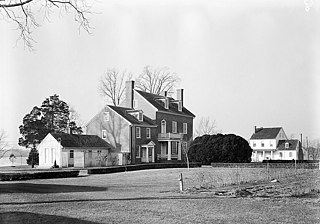
Potter Hall is a historic home located at Williston, Caroline County, Maryland, United States. It is an early-19th-century, Federal-influenced house facing the Choptank River. The house was constructed in three sections: a tall 2 1⁄2-story Flemish bond brick structure built about 1808 adjoining a lower 2 1⁄2-story, two-bay-wide central section built about 1750, also of Flemish bond brick, then a frame single-story kitchen wing added in 1930. Each of the three sections has a gable roof. Potter Hall was originally settled by Zabdiel Potter, who in the mid-18th century built a wharf and the small brick house. He developed Potter's Landing into a key early port for the shipping of tobacco to Baltimore.

Hitt's Mill and Houses, also known as Pry's Mill, Valley Mills, Hitt House, is a historic home and mill complex located at Keedysville, Washington County, Maryland, United States. It is a five-story stone and brick structure built as a grist mill. The ground story and the first full story above ground level are constructed of coursed limestone; the upper stories are built of brick. Also on the property is a square log outbuilding with a hipped roof, a large frame bank barn, and part of a fieldstone barnyard fence. The mill and the Hitt house served as hospitals during and after the nearby Civil War Battle of Antietam.

The Wye Town Farm House is a historic home in Easton, Talbot County, Maryland, United States. It is of brick construction, one and one-half stories high and two rooms deep with a small one-story brick kitchen. A two-story addition was made in the 20th century. The original section of the house dates from about 1800.
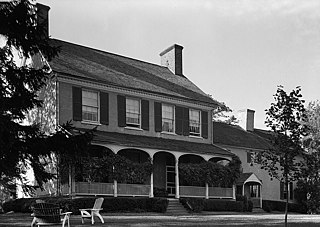
Prospect Hill is a historic home located at Long Green, Baltimore County, Maryland, United States. It was designed by architect William Thornton and built between 1796 and 1798. It is a 2 1⁄2-story Federal style brick house.

Bohemia Farm, also known as Milligan Hall, is a historic home located on the Bohemia River at Earleville, Cecil County, Maryland. It is a five bays wide, Flemish bond brick Georgian style home built about 1743. Attached is a frame, 19th century gambrel-roof wing. The house interior features elaborate decorative plasterwork of the Rococo style and the full "Chinese Chippendale" staircase. It was "part-time" home of Louis McLane.
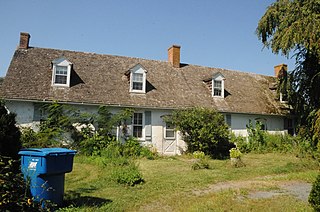
White House Farm is a historic home located at Kennedyville, Kent County, Maryland, United States. The oldest section of the 1 1⁄2-story stuccoed brick house was built in 1721. The house is located on an elevated site, within an informally landscaped yard which retains evidence of historic terracing. Also on the property is a late-19th-century brick dairy.

Bishopton is a historic home located at Church Hill, Queen Anne's County, Maryland. It is a 1 1⁄2-story, brick dwelling, three bays wide, and one room deep with a hall-parlor plan in the 18th century Tidewater Maryland/Virginia vernacular style It was built about 1711. The facades are laid in Flemish bond and the upper gables feature glazed chevron patterns.

Engine House No. 8 was a historic fire station located at Baltimore, Maryland, United States. It was a two-story masonry building with a cast-iron street front, erected in 1871 in the Italianate style. The front featured a simple cornice with a central iron element bearing the legend "No. 8". Engine Company No. 8 operated from this building until 1912. In 1928 it became the motorcycle shop of Louis M. Helm and the upper story functioned as a clubhouse for a series of boys’ clubs into the 1940s.
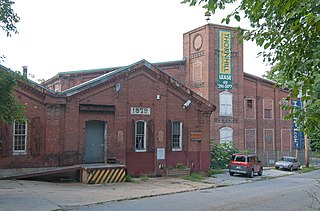
Mount Vernon Mill No. 1 is a historic cotton mill complex located at Baltimore, Maryland, United States. It was constructed between 1873 and 1918 and consists of four buildings situated along Jones Falls. The complex consists of three closely associated 19th century buildings and a 20th-century warehouse. There is a large, three-story brick Mill Building (1873); a two-story, brick, "L"-shaped Picker House (1873); a two-story, brick Store House ; and a later, reinforced-concrete warehouse (1918). It served as headquarters for Mount Vernon-Woodberry Mills, one of the world's largest producers of cotton duck.

Londontown Manufacturing Company, Inc., also known as Meadow Mill, is a historic cotton mill complex located at Baltimore, Maryland, United States. It is a three-story, Italianate brick structure that features a square tower structure with a truncated spire-like roof having an open bell cupola. It was erected in 1877 as one of five mills which comprised the Woodberry Manufacturing Company. It was intended for the manufacture of seine twines. It was home to London Fog, prior to its move to Eldersburg, Maryland.

Caves Valley Historic District is a national historic district near Owings Mills, Baltimore County, Maryland, United States. It is located in a natural upland valley encompassing about 2,100 acres (8.5 km2) along the North Branch of the Jones Falls and its contributing courses. It includes cultivated fields, pastures, woodlands, streams, housing clusters, and agricultural structures. The vernacular buildings are log, stone, and frame, reflecting the local materials and functional plans of rural locations in the 18th and 19th centuries.
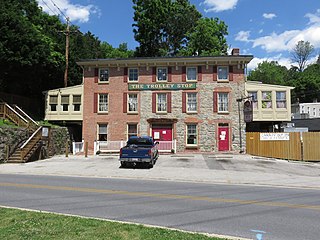
Ellicott's Mills Historic District is a national historic district at Oella, Baltimore County, Maryland, United States. It is on the east bank of the Patapsco River, opposite Ellicott City. It relates to the industrial operations of the Ellicott family from the 1770s through the mid-19th century. It consists of the sites of historic buildings including: an 18th-century building, a section of an 18th-century mill incorporated in a 20th-century factory, a 19th-century tavern, 19th-century workers housing, and an 1859 Italianate villa built by John Ellicott, united by the major east–west route in Maryland during the early 19th century, the old National Pike. Also in the district is the mammoth multi-story Wilkins-Rogers Company flour plant, which is located on the site of the 1792 Ellicott Flour Mill, the first merchant flour mill in the United States.
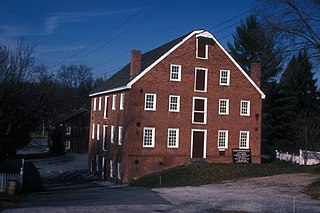
Union Mills Homestead Historic District is a national historic district at Westminster, Carroll County, Maryland, United States.
























